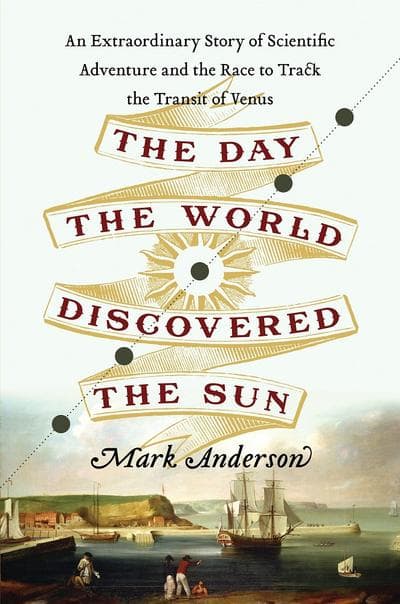Advertisement
How The Transit Of Venus Changed Life On Earth
Resume
There's a celestial treat in store for Tuesday: the transit of Venus. The astronomical event happens about once every century, when Venus passes between the earth and the sun.
The next transit? The year 2117.
The transit of Venus isn't just rare, it's a profoundly important astronomical event. In 1769, scientists observing the phenomenon recorded data that later solved two of the most important puzzles of the 18th century.
"One is, how far is the most important thing in the universe to us, the sun?" said Marc Anderson. "The other is navigation. How far is the shore?"
In his new book, "The Day The World Discovered The Sun", Anderson writes about the global chase to find the best places to measure the transit of Venus, an "Amazing Race", 18th century style. He focuses on three scientific teams led by three unique men: France's Jean-Baptiste Chappe; England's Captain James Cook; and the Vatican's Father Maximilian Höll.
The data they gathered came at a high cost. Lives were lost. But it achieved its ultimate goal. In 1771, astronomer Thomas Hornby collated the findings and first estimated the distance between the Earth and sun: 93,726,900 miles.
He was off by less than 0.5 percent.
"No one had ever traveled faster than the speed of the fastest horse. No one had been higher off the ground than the tallest cathedral spire," said Anderson. "And yet they were able to inch out a measuring line into the solar system, and mark out the distance to the sun from all the planets with greater than 99-percent accuracy. It's quite a testimonial to how the human spirit to know, and to come to know our world endures."
The multi-team approach to the 1769 transit of Venus also marks the first time scientists undertook true international collaboration. Anderson believes it was unlike anything seen before in human history.
"Today we can think of many examples of international collaborations: the Large Hadron Collider. The Human Genome Project. The International Space Station. They all find their origins in this set of exploration in the 1760s...This idealistic age that's trying to solve the great problems of their time, sending out the greatest minds and explorers to the four corners of the earth," Anderson said.
It also inspired great poetry. In 1775, a scientist on Cook's ship took a teaching appointment at a London school. He shared fantastic tales of his Pacific and polar adventures. One of his star pupils was a young Samuel Taylor Coleridge, who later wrote the classic poem, "The Rime of the Ancient Mariner":
The western wave was all a-flame
The day was well nigh done!
Almost upon the wave
Rested the broad bright sun
When that strange shape drove suddenly
Betwixt us and the sun.
Guests:
- Mark Anderson, author of "The Day The World Discovered The Sun"
Where To View Venus' Passage Across The Sun:
- The Harvard-Smithsonian Center for Astrophysics in Cambridge will hold a rooftop viewing at 6 p.m. No reservations are required. Parking is available at Center for Astrophysics lots beginning at 5 p.m. at 60 Garden Street, 160 Concord Avenue, and the lot on Bond Street between Garden Street and Concord Avenue.
- Weather permitting, the Museum of Science will be hosting a free viewing on its garage roof. Space is limited, so attendees must register in advance.
- At Boston University, viewing stations will be set up on the rooftop of 685 Commonwealth Ave., on a grassy area at the corner of Commonwealth Avenue where it crosses over the Mass. Pike, and at the corner of St. Mary’s Street and Commonwealth Avenue.
- Timothy Brothers, site manager of MIT's George R. Wallace Jr. Astrophysical Observatory, will be at the Groton town gazebo from 6 to 8:15 p.m. Tuesday to offer commentary and tips for viewing the transit of Venus. For more information or to register for the free program, call the Groton Public Library at 978-448-1168.
From the book "The Day The World Discovered The Sun" by Mark Anderson. Reprinted by arrangement with Da Capo Press, a member of the Perseus Books Group. Copyright © 2012.
This segment aired on June 4, 2012.